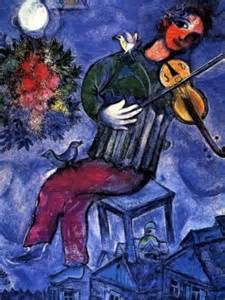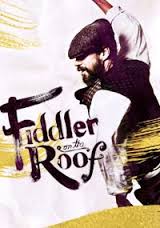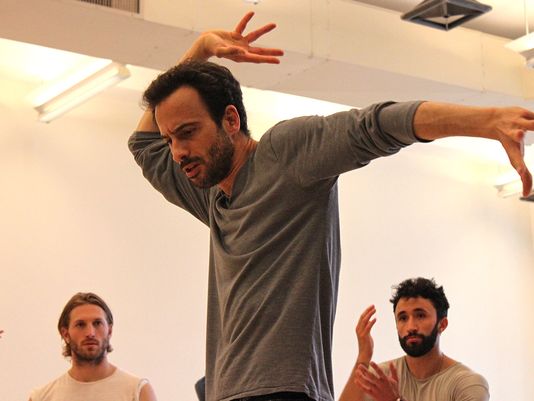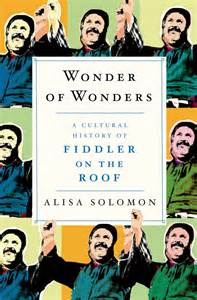 What do Bea Arthur, Adrienne Barbeau, Barbara Barrie, Hershel Bernardi, Michael Bernardi, Theodore Bikel, Danny Burstein, Sacha Baron Cohen, Burt Convy, Harvey Fierstein Fyvush Finkel, Paul Michael Glaser, Josh Groban, Andrea Martin, Andrea Martin, Bette Midler, Alfred Molina ,Zero Mostel, Leonard Nimoy, Rosie O’Donnell, Austin Pendelton, Molly Picon, Neva Small, Isaac Stern, Topol, Pia Zadora, and Louis Zorich have in common?
What do Bea Arthur, Adrienne Barbeau, Barbara Barrie, Hershel Bernardi, Michael Bernardi, Theodore Bikel, Danny Burstein, Sacha Baron Cohen, Burt Convy, Harvey Fierstein Fyvush Finkel, Paul Michael Glaser, Josh Groban, Andrea Martin, Andrea Martin, Bette Midler, Alfred Molina ,Zero Mostel, Leonard Nimoy, Rosie O’Donnell, Austin Pendelton, Molly Picon, Neva Small, Isaac Stern, Topol, Pia Zadora, and Louis Zorich have in common?
If you guessed that they had all been in a production of Fiddler on the Roof, you’d be right. And the list of actors and actresses who were being considered for or who wanted to be in Fiddler and were either rejected or never even got a chance to audition is equally impressive. It reads like a who’s who of Broadway and Hollywood talent: Anne Bancroft, Robert D Niro, Richard Dreyfuss, Lee Grant, Alan King, Walter Matthau, Beverly Sills, ,Frank Sinatra, Danny Thomas, Nancy Walker, Eli Wallach, Gene Wilder, and more.
A little more than 51 years after the show opened on Broadway in 1964, a new production is on the boards for today’s Broadway goers. It’s popularity is undeniable: it was the first musical to play for more than 3000 performances and for almost 10 years held the record for the longest running musical until it was displaced by Grease.
 In additional to the well-known movie, there have been Broadway stagings in 1964, 1976, 1981, 1990 and 2004. Fiddler is one of the most produced high school productions and songs from the show have become standards at weddings worldwide. There have been productions in several languages across the globe.
In additional to the well-known movie, there have been Broadway stagings in 1964, 1976, 1981, 1990 and 2004. Fiddler is one of the most produced high school productions and songs from the show have become standards at weddings worldwide. There have been productions in several languages across the globe.
Why another Fiddler? Because this is a timeless iconic story: Tevye, the everyman, just wants to get along with his life. He struggles with family problems, with changes in societal customs and mores, and faces the challenges and tragedies that minorities have always faced. Tevye’s problems are not only Jewish struggles- although this is a throughly Jewish production- but the struggles of people worldwide. Change the scene,change the time, change the names and you will see today’s headlines.
This production makes Tevye a little less of a buffoon as he may sometimes appear. Golde, his wife, is not as shrewish; there is real affection between the two. Even Yenta is not quite so strident. The audience can feel even for her, a childless widow who has become a perpetual complainer.
 This new production surrounds Tevye’s story with a modern frame. A curtainless stage greets the audience. There is nothing on the stage but a chair and a sign in Cyrillic-ANATEVKA. A man wearing a red parka – one of the few touches of bright color-and carrying a book walks out onto the empty stage, stops in front of the sign, looks at his book and back at the sign. In the blink of an eye, the man dons a cap, pulls out the tzitzis on his tallit katan and transforms himself into Tevye, the shtetl dweller and as the play begins we are drawn into the world of Tradition. Who is the man? Tevye’s grandson? A curiosity seeker? A time traveler?
This new production surrounds Tevye’s story with a modern frame. A curtainless stage greets the audience. There is nothing on the stage but a chair and a sign in Cyrillic-ANATEVKA. A man wearing a red parka – one of the few touches of bright color-and carrying a book walks out onto the empty stage, stops in front of the sign, looks at his book and back at the sign. In the blink of an eye, the man dons a cap, pulls out the tzitzis on his tallit katan and transforms himself into Tevye, the shtetl dweller and as the play begins we are drawn into the world of Tradition. Who is the man? Tevye’s grandson? A curiosity seeker? A time traveler?
As the musical ends and the villagers, forced from their homes, hoist their bags and drag their carts and wagons, the man again appears, but this time he takes Tevye’s place in the line of migrants.
We are all immigrants. We are all as tentative as the Fiddler-inspired by Marc Chagall’s painting- balancing on that steep roof.
The scenery is spare and flexible with a folklike quality to it. At times, the buildings float, like the fiddler; at other times, the walls appear to resemble prison bars, especially as the tension rises. The costumes are predominantly browns and greys; there is little sunshine, but there is joy in the hard-working villagers’ lives. The many shadows cast by the angularity of the dancers’ bodies feel at once both traditional and modern.
Some critics felt that earlier productions were not Jewish enough. Jewish customs are integral to the production but they do not overwhelm it. The Sabbath scene which originally took place in lighted windows, now features a variety of households standing around their individual Sabbath tables: families with children, widows, multigenerational families, all lighting their candles and blessing the wine and bread just a beat behind each other. Their Judaism is not self-conscious but part of their lives.
This production has received almost universal rave reviews from professional critics. If the clapping, laughing and sniffling is any indication, the audience felt the same.
No matter how many times you’ve seen Fiddler on the Roof, it’s time to see it again. Go yourself. Take your children. Take your grandchildren.
A new generation deserves to see this timeless musical.
Related reading:
For young readers:
- Sholom Aleichem, Holiday Tales.
- Silverman, Sholom’s treasure: how Sholom Aleichem became a writer
For adult readers:
- Isenberg, Tradition: the highly improbable, ultimately triumphant Broadway toHollywood story of Fiddler on the Roof, the world’s most beloved musical.
- Sholom Aleichem, Motel, the cantor’s son. Tevye, the dairyman and the railroad stories.
- Solomon, Wonder of wonders: a cultural history of Fiddler on The Roof.
- Is It Passover Yet? - Thu, Apr 18, 2024
- MESH Report April 9, 2024 - Thu, Apr 11, 2024
- Guess Who? - Wed, Mar 13, 2024

I want to see this – just need to be home long enough